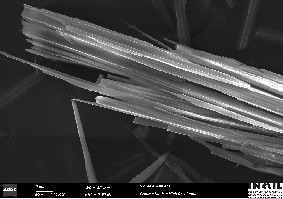Crystal chemistry of natural occurring asbestos tremolite from calabrian ophiolites
DOI:
https://doi.org/10.13133/2239-1002/17410Keywords:
Tremolite, Naturally Occurring Asbestos (NOA), SEM-EDS, Mössbauer spectroscopy, Rietveld methodAbstract
The present work reports a detailed chemical and structural characterization of a fibrous tremolite sample from an abandoned serpentine quarry located in Mount Reventino (Calabria, Italy), by using SEM-EDS analysis, Mössbauer spectroscopy, and X-ray powder diffraction. Cell parameters, fractional coordinates and site scattering were refined using the Rietveld method. Results showed that the sample contains small amount of Fe, being the % ferro-actinolite content of ca. 3%. In particular, Fe2+ is preferentially allocated at M(1)+M(3) octahedral sites, and Fe3+ only occurs at M(2). Combining chemical, spectroscopic and structural data the following empirical formula has been derived:
A(Na0.124)Σ0.124M(4)(Ca1.922Na0.003Fe2+0.026Mg0.049)Σ2.000[M(1)(Mg1.960Fe2+0.040)Σ2.000M(2)(Mg1.963Fe3+0.024Fe2+0.013)Σ2.000 M(3)(Mg0.931Fe2+0.069)Σ1.000] [T(1)(Si3.946Al0.024)Σ3.970 T(2)(Si4.000)] O22 O(3)(OH2.000)Σ2.000.
Considering that both the presence of Fe and its coordination environment within the mineral structure are primary factors for pathological effects, the identification of Fe bearing asbestos tremolite in the investigated area may represent a potential hazard for human health.
Downloads
Published
Issue
Section
License
Copyright (c) 2021 Alessandro Pacella, Paolo Ballirano, Henrik Skogby, Federica Angelosanto, Angelo Olori, Annapaola Cannizzaro, Maria Rosaria Bruno, Francesco Sinopoli, Antonella Campopiano

This work is licensed under a Creative Commons Attribution 4.0 International License.

